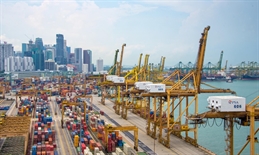
As ocean freight container shipping spot rates continued to spike dramatically in July amid persisting supply chain disruptions, Xeneta warned shippers and carriers about the potential implications of their actions for the rate increase moving forward.
Peter Sand, chief analyst at Xeneta, stated that while spot rates might not reach the levels seen during the COVID-19 pandemic, the duration and extent of their increase will mainly depend on how shippers and carriers respond to these disruptions.
"At this point, it is not likely we will see the spot market reach the heights of the Covid-19 pandemic, but it cannot be ruled out completely, and the response of both shippers and carriers in the coming months could be decisive," Sand said in the analysis.
He added that from a shipper perspective, they should keep their cool and refrain from pushing the panic button, as we saw in the first four months of 2024 with the frontloading of imports – particularly into Europe.
"This increased demand ahead of the traditional Q3 peak season is one of the factors driving the market upwards," Sand said.
From a carrier perspective, he noted that they need to do everything they can to ease port congestion and stop calling at the same transhipment hubs in Asia and Europe.
"If this does not happen – and there is no change to the situation in the Red Sea – then spot rates will continue to climb," the Xeneta chief analyst further said.
The report noted that average spot rates from the Far East to North Europe have continued to rise in July to reach US$7,897 per FEU – which means spot rates on this trade have now passed the halfway point (53%) in the climb towards the pandemic peak of US$14,783 in January 2022.
Average spot rates on trades from the Far East to the US East Coast and US West Coast are even closer to their pandemic peaks in early 2022 at 72% and 79%, respectively.
Xeneta said the current average spot rate of US$7,648 from the Far East to the US West Coast is an increase of 366% since December 14 last year before the escalation of conflict in the Red Sea. The average spot rate of US$9, 146 on the East Coast is an increase of 268% in the same period.
Congestion pain points
The analysis noted that Singapore, the world's largest transshipment hub, has become an "epicenter of disruption" in the Far East, although it noted that the port congestion has now spread to neighboring Malaysian hubs with Port Klang recording all-time-high congestion on July 1.
"Volumes at Tanjung Pelepas are reportedly up by 20% this year also, however MMC and APM Terminals, which run the port, have claimed the 1.078 million TEU in May 2024 was handled without any congestion," it said.
Sand pointed out that the congestion in global supply chains is understandable in many respects because carriers have tried to reduce the impact of longer sailing distances around the Cape of Good Hope by stopping at fewer ports — but noted that they almost all still stop at Singapore (or nearby).
For example, he said that Hapag-Lloyd has restarted a China-Germany service (CGX) that has not run since the pandemic. The service only has five port calls, but one of them is Singapore.
"With the average TEU of each ship arriving in Singapore rising by 18.5% from January to May, it is not surprising to see congestion has now reached its second-highest level ever, and just 1.9% shy of the August 2021 record of 2,997 TEU per containership arrival," Sand added.
Meanwhile, he noted that lessons are "quickly being learned by some carriers" with MSC, for example, launchinga 'premium service' in mid-June — originally scheduled to stop in Singapore on its way to Europe, but the service now sailing directly to Liverpool from China/Vietnam.
"This is not a case of pointing fingers at carriers because reducing reliance on the world's biggest transhipment hub is easier said than done. But the actions of carriers in the coming weeks and months may determine whether the current level of congestion lasts until the end of 2024 or beyond into 2025 — and whether freight rates will keep climbing," Sand said.
In terms of shippers, the Xeneta chief analyst noted that shippers can play a part in helping to ease the pain points in global supply chains by remaining calm and collected.
"We do not yet know how high spot rates will climb – and we can expect an impact on the long term market. If shippers do want to wrestle back some control over the situation, then they should keep as many options open as possible," he added.



